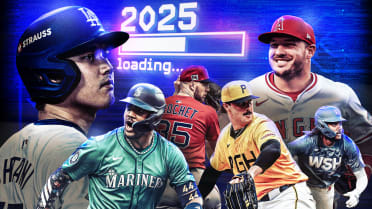Reds studying 2023 Draft to add another key piece to franchise
This story was excerpted from Mark Sheldon’s Reds Beat newsletter. To read the full newsletter, click here. And subscribe to get it regularly in your inbox.
WASHINGTON D.C. -- The entirety of the 2023 MLB Draft is important to the Reds but one look at the club's roster underscores how crucial the first-round pick can be.
Cincinnati's run as a surprise contender for the National League Central Division race is fueled by the contributions of six of their past first-rounders -- Tyler Stephenson (2015), Nick Senzel (2016), Hunter Greene (2017), Jonathan India (2018), Nick Lodolo (2019) and Matt McLain (2021). The club also committed wholeheartedly to upgrading its player development system in 2022 when several veteran players were traded for prospects.
“We know the team is playing well right now and it’s a lot of high draft picks that are contributing to it. But we can’t stop and rest on our laurels there," Reds director of amateur scouting Joe Katuska said. "We’ve got to keep this process going and keep restocking the system every single year.”
The 2023 MLB Draft is July 9-11 during All-Star Week in Seattle. It will feature 20 rounds across the three days, with the first two rounds airing on MLB Network and MLB.com at 7 p.m. ET Sunday.
Although they had a 62-100 record in 2022, the Reds missed getting a top-six pick in last winter's Draft Lottery. They have the seventh selection in the first round but also the 38th overall pick in Competitive Balance Round A and at No. 43 overall in the second round.
Last year, the Reds picked third baseman Cam Collier with the 18th overall pick. Moving up to No. 7 this year has its advantages.
“It really helps us kind of cut down the player pool that we thought was going to be in range earlier in the spring," Katuska said. "So we were able to get more targeted looks at those guys that really fit at the top of the class. Not to say we didn’t scout everyone, but we had a better idea early of the grouping of players that will really be in range.”
This is Katuska's second year of running the Reds' Draft but his 19th in the organization. His tenure overseeing the "war room" has not deviated much from his predecessors in that the entire Draft process remains a collaborative effort.
“Without a doubt. The board we put together is the organization’s board. It’s not the board of any one individual in the room," Katuska said. "We use all the information we have -- the scouts’ opinions, all the analytics work, the [player] makeup work we do off the field -- everything goes into it.”
Here is more information about the Reds heading into the Draft:
Spending money
Each team gets an allotted bonus pool equal to the sum of the values of its selections in the Draft. The more picks a team has, and the earlier it picks, the larger the pool. Each selection in the top 10 rounds comes with an assigned value (slot value), and the total for each club’s selection equals what it can spend in those rounds without incurring a penalty.
Clubs that outspend their allotment by 0-5 percent pay a 75 percent tax on the overage, and clubs lose future picks at higher thresholds. If a player taken in the top 10 rounds doesn’t sign, his pick’s value gets subtracted from the team’s pool.
The Reds have a total pool of $13,785,200 to spend, the sixth-largest in the Major Leagues, with a slot value of $6,275,200 for the seventh pick, $2,255,100 for the 38th pick and $1,998,200 for the 43rd selection.
Who might they take?
As Katuska noted, the Reds have the luxury of narrowing their board somewhat at No. 7. In a recent mock draft, MLB.com reporter Jim Callis targeted Rhett Lowder, a right-handed pitcher from Wake Forest, for Cincinnati. But if high school outfielders Max Clark or Walker Jenkins are still available, the Reds could pivot to one of them.
Trend watch
The Reds have zeroed in on college players in the past few Draft cycles. In 2022, 18 of their 22 selections came from the college level.
"It’s really just been that best player available," Katuska said. "A lot of times with signability concerns, the overall number of players you draft and sign is going to lean heavily to college."
Senior Reporter Mark Sheldon has covered the Reds for MLB.com since 2006, and previously covered the Twins from 2001-05.




